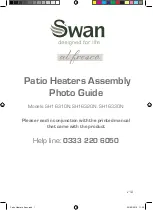
Installation & Operation Manual
32
5
Vertical direct venting
Vent/air termination – vertical
Prepare roof penetrations
1. Air pipe penetration:
a. Cut a hole for the air pipe. Size the air pipe hole as
close as desired to the air pipe outside diameter.
2. Vent
pipe
penetration:
a. Cut a hole for the vent pipe. For either
combustible or noncombustible construction, size
the vent pipe hole with at least a 1/2 inch clearance
around the vent pipe outer diameter:
• 4½ inch hole for 3 inch vent pipe
• 5½ inch hole for 4 inch vent pipe
• 7½ inch hole for 6 inch vent pipe
b. Insert a galvanized metal thimble in the vent pipe
hole.
3. Space the air and vent holes to provide the minimum
spacing shown in FIG. 5-1A, page 31.
4. Follow all local codes for isolation of vent pipe when
passing through floors, ceilings, and roofs.
5. Provide flashing and sealing boots sized for the vent
pipe and air pipe.
Termination and fittings
1. Prepare the vent termination coupling and the air
termination elbow (FIG.’s 5-1A and 5-1B) by inserting
bird screens. Bird screens should be obtained locally.
2. The air piping must terminate in a down-turned 180°
return bend as shown in FIG.’s 5-1A and 5-1B. Locate
the air inlet pipe no further than 2 feet from the center
of the vent pipe. This placement avoids recirculation of
flue products into the combustion air stream.
3. The vent piping must terminate in an up-turned
coupling as shown in FIG. 5-1A. The top of the
coupling must be at least 1 foot above the air intake.
When the vent termination uses a rain cap as illustrated
in FIG. 5-1B maintain at least 36" (914 mm) above
the air inlet. The air inlet pipe and vent pipe can be
located in any desired position on the roof, but must
always be no further than 2 feet apart and with the vent
termination at least 1 foot above the air intake.
4. Maintain the required dimensions of the finished
termination piping as shown in FIG.’s 5-1A and 5-1B.
5. Do not extend exposed vent pipe outside of building
more than shown in this document. Condensate could
freeze and block vent pipe.
Multiple vent/air terminations
1. When terminating multiple Armor water heaters, terminate
each vent/air connection as described in this manual
(FIG. 5-2).
Terminate all vent pipes at the same height
and all air pipes at the same height to avoid
possibility of severe personal injury, death,
or substantial property damage.
2. Place roof penetrations to obtain minimum clearance of
12 inches between edge of air intake elbow and adjacent
vent pipe of another water heater for U.S. installations (see
FIG. 5-2). For Canadian installations, provide clearances
required by CSA B149.1 Installation Code.
3. The air inlet of an Armor water heater is part of a direct vent
connection. It is not classified as a forced air intake with
regard to spacing from adjacent water heater vents.
12” MINIMUM VERTICALLY
FROM VENT OUTLET TO
ANY AIR INLET
12” MINIMUM FROM EDGE OF AIR
INTAKE PIPE TO ADJACENT VENT
PIPE FROM ANOTHER WATER HEATER
AIR
VENT
AIR
VENT
Figure 5-2 Vertical Terminations with Multiple Water
Heaters
Figure 5-3 Alternate Vertical Terminations with Multiple
Water Heaters
WARNING
















































